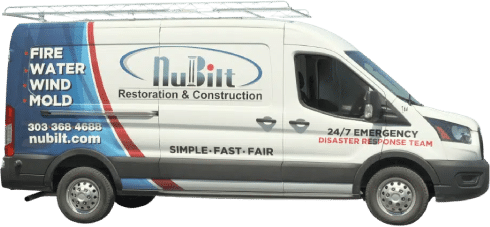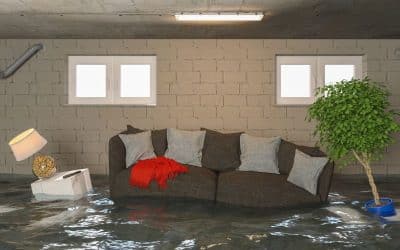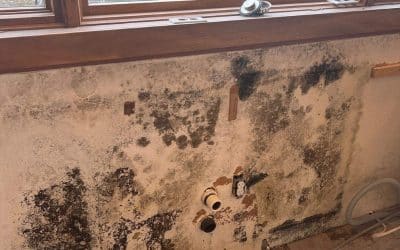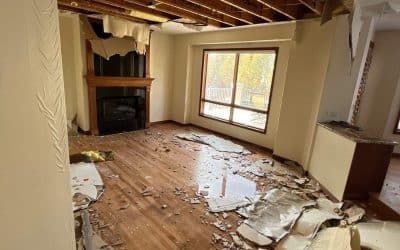The Hidden Language of Water Damage
Water damage doesn’t always announce itself with dramatic flooding or obvious leaks. Often, it speaks in whispers – subtle changes in your walls and floors that might go unnoticed until significant damage has occurred. This guide will help you identify these early warning signs before they escalate.
Wall Indicators: Reading Between the Lines
Your walls can tell you a lot about potential water damage. Here are key signs to watch for:
Color Changes and Staining
Water leaves distinctive marks. Yellow or brown rings often indicate progressive water damage, while dark spots might suggest more recent issues. In Denver’s dry climate, these stains can be subtle due to rapid evaporation.
Texture Transformations
Pay attention to any changes in your wall’s texture. Water-damaged drywall might feel spongy or soft, while painted surfaces might bubble or peel. Denver’s higher elevation can also create unusual texture patterns due to how moisture behaves within wall materials.
Structural Warning Signs
Watch for warped or bulging walls. These deformations often indicate water accumulation behind the surface. Cracking or separation at wall joints is a clear signal that you need professional “water damage restoration near me” services immediately.
Floor Signs: Understanding Ground-Level Warnings
Your floors, especially in basements and ground-level rooms, can also provide early warnings.
- Surface Changes: Look for cupping or crowning in wooden floors, separation between floorboards, darkening or discoloration, or unexplained dampness when walking.
- Structural Integrity Issues: Denver’s freeze-thaw cycles can exacerbate water damage in flooring. Watch for uneven or sloping areas, squeaking or shifting underfoot, soft spots (particularly near exterior walls), or cracking in tile or concrete.
Basement-Specific Indicators
Basements are particularly vulnerable in Colorado’s variable weather. Key signs include efflorescence (white, powdery mineral deposits on walls), musty odors, condensation on walls or floors, and water seepage after snow melts or heavy rains.
Hidden Damage: Looking Beyond the Surface
Some of the most serious water damage occurs out of sight. Understanding these hidden indicators can help you spot problems early:
- Behind-the-Wall Signs: Unusual sounds in your plumbing, unexplained increases in water bills, persistent musty odors, or changes in wall temperature.
- Environmental Markers: Increased indoor humidity levels, foggy windows, mold growth in unexpected places, or persistent condensation.
Assessment and Action: Making Informed Decisions
When you spot potential water damage, proper assessment is crucial:
- Immediate Steps: Document all visible signs with photos, check for active leaks, monitor the affected area for changes, and contact professionals for evaluation.
- Professional Assessment: When searching for “water damage restoration near me” in Denver, look for experts who understand local building codes and requirements, high-altitude effects on moisture behavior, Denver’s specific construction methods, and regional weather impact.
Long-Term Prevention Strategies
Protecting your Denver home requires proactive measures:
- Regular Inspections: Check your roof and gutters before snow season, inspect basement seals and waterproofing, monitor plumbing systems for leaks, and assess window and door seals seasonally.
- Climate Considerations: Denver’s unique environment requires special attention to snowmelt management, proper drainage systems, freeze-thaw cycle protection, and humidity control.
Understanding Your Home’s Vulnerabilities
Different home styles and ages present unique challenges:
- Historic Homes: Older Denver homes may have traditional construction materials more susceptible to water damage, original plumbing systems that need extra attention, and historic preservation considerations for repairs.
- Modern Construction: Newer homes often benefit from advanced waterproofing techniques, modern materials with better moisture resistance, and updated building codes and standards.
When to Call Professionals: Recognizing the Urgency
Some situations require immediate professional attention:
- Emergency Indicators: Standing water or active leaks, structural deformation, electrical system exposure to water, or extensive mold growth.
- Health and Safety Concerns: Respiratory issues or unusual odors, visible mold growth, compromised structural elements, or water contamination risks.
Frequently Asked Questions
How can I tell if water stains are new or old? Fresh stains typically appear darker and may feel damp. Older stains usually have defined edges and may show multiple rings. In Denver’s dry climate, stains can sometimes appear differently than in more humid regions.
What water damage signs indicate an emergency? Structural deformation, electrical system exposure to water, extensive mold growth, or standing water require immediate professional attention.
How does Denver’s climate affect water damage patterns? Our high elevation and semi-arid climate create unique moisture behavior. Rapid temperature changes and freeze-thaw cycles can accelerate damage, while low humidity can mask some common indicators.
What hidden water damage signs should I look for in my basement? Focus on musty odors, efflorescence, condensation patterns, and any changes in floor or wall texture. Denver’s snowmelt seasons require extra vigilance.
Lesser-Known Considerations
How does the age of my Denver home affect water damage? Different construction eras used varying materials and techniques. Older homes might show damage differently than modern construction.
What role does Denver’s elevation play? Our high altitude affects evaporation rates and how materials respond to moisture.
How do different wall materials show water damage? Drywall, plaster, and various sidings each display unique indicators.
Protecting Your Denver Home: Act Now
Water damage in Denver homes presents unique challenges due to our climate and elevation. By understanding these signs and knowing when to seek professional help, you can protect your home and family. Remember, early detection and prompt action are your best defenses against extensive water damage. Don’t wait until it’s too late – NuBilt can help! If you suspect water damage, contact a qualified “water damage restoration near me” specialist today at NuBilt. We are here to protect your investment, protect your health, and protect your peace of mind.






